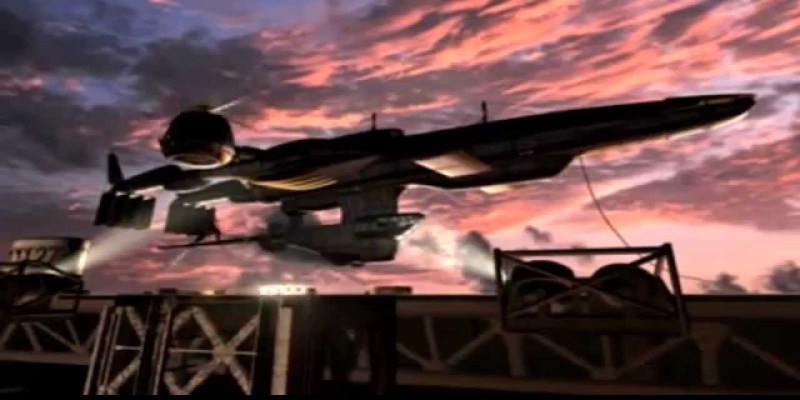Years after first announcing the project, Square Enix finally showed off a playable version of the Final Fantasy VII Remake at E3 2019. The 1997 original is widely regarded as one of the best RPGs, if not one of the best games of all time. While watching the trailer, I marveled at the magnificent hair movement and facial expressions and admired the sweet coo of Barret Wallace mowing down an enemy with his gun arm.
Still, I found it unforgivable that the trailer left out my favorite character from Final Fantasy VII: the Highwind.
The airships of the Final Fantasy series are half-airplane, half-helicopter, half-sailboat, half-balloon contraptions and all impossibly romantic. While the primary mode of transportation in Final Fantasy games is walking, airships aren’t far behind. They have become staples of the Final Fantasy skies, allowing you to quickly zip across the map to previously inaccessible areas without dealing with random enemies.
But airships serve more than a pragmatic purpose: they’re plot-escalators, removing the filler of random battles in favor of rare loot or exciting new characters like Gogo, Final Fantasy VI’s mimic draped in so many colorful blankets that you can’t tell if they’re human. The airship fleet also offers a chance to revisit old haunts to further develop and sort out the story, and to really feel the gravity of the world-ending threat at the core of each plot. In Final Fantasy, airships are your ride, a home for your newly gathered surrogate fantasy families, and your chapter markers.
The Highwind in particular strikes my fancy because it oozes home-spun charm. Its exterior is cobbled together with patchwork metal panels accompanied by what appears to be lengths of twine. A look at the inside instills less confidence. It’s filled with stray metal bars opening pathways, mysterious barrels and crates blocking others, and arrows on the ground indicating from which direction you should navigate the labyrinth. Like the Millennium Falcon, it feels like a dilapidated hunk of junk with no business being in the air.
Where the Falcon had its Han Solo, the Highwind has Cid Highwind, a rough-and-tumble mechanic and wannabe astronaut who wields a spear, wears aviator goggles like a hat, and manages to battle with a cigarette drooping from his mouth which he inevitably takes a luxurious drag from after each battle victory. He designed and built the Highwind from scratch and was devastated when Shinra, the game’s big bad corporation, hijacked the ship for its own use.

Your team eventually reclaims the Highwind and it affords you a dire view. Venture over the dystopian industrial city of Midgar, where you started your adventure, and you see a neon green tower jutting up from a large radius of scorched earth. The blackness creeps away from the city and seems to be expanding rapidly. It’s revolting. Before then, your perspective on Midgar’s catastrophic impact on the environment has been terrestrial; you see its blight inside the city and briefly when you walk away from it into the still-green countryside beyond. The Highwind, however, gives you a god’s eye view of the wounded planet. It’s a hell of a motivator to fight.
The airship’s history of ushering in defining moments begins in the original Final Fantasy. Once you receive the airship, you are granted the opportunity to visit the dragon king Bahamut and evolve your characters into more powerful forms. Fighters become warriors, mages become wizards. It’s all very exciting. This airship carries the simple design repeated in future games. It looks like a sea-faring ship but with propellers affixed instead of sails. Like in other games, your party avoids enemy encounters when riding on the airship, affording you the opportunity to perform reconnaissance work and just take a break from facing random enemies.
Final Fantasy II doesn’t expand on the design of the airship, but it introduces Cid as the series’ perennial airship-obsessed character. He takes many forms over the years: Here he’s a knight who defects from an evil empire in his airship to seek his own fortune. In other entries — there is no direct canon in numbered Final Fantasy games — he’s a kooky engineer. He even serves as the headmaster of a school for teenage mercenaries in Final Fantasy VIII.

Why Cid? In 1997, Hironobu Sakaguchi, creator of the Final Fantasy series, told EGM2 magazine, “There really isn’t any deep meaning to it, we just wanted to make a character that would appear in various forms in all the games. I guess I’ve always had a soft spot for that kind of character. Cid is like Yoda from the Star Wars series — very intelligent and wise.”
His vast intelligence and wisdom could not be contained to merely games he was physically in. The developers changed some dialogue for future remakes of the original Final Fantasy so people would talk about a mythical Cid responsible for the airship. Or, as the case may be, airships. Final Fantasy III introduced the idea of having multiple airships in a game, but it wasn’t until Final Fantasy IV that each came to represent an act in a play. First you acquire the Enterprise, which shepherds you around the overworld until you arrive underground in the land of hot magma and dwarf kingdoms. The Falcon, stolen from the bad guys, allows you to move freely between the overworld and underground thanks to a drill affixed to the front by Cid Pollendina, who had the foresight to perform his engineering duties in a spandex bodysuit. Once the surface and the underworld are conquered, there’s nowhere else to go but up. To the moon! Your vessel is the Lunar Whale, a mammoth black ship that eclipses entire towns with its obese hull. It looks like what would have happened if God made an origami plane out of an actual whale husk.
Each of the airships in Final Fantasy IV serve to equip you with the tools you need, such as when Cid’s engineers affix a small crane to the Enterprise so you can acquire badass endgame ninja Edge Geraldine. Whether it’s above ground, below ground or on the moon, the airships offer a brief respite before the oncoming storm.
Final Fantasy IV is also noteworthy in that it positions Cid as a playable character. Prepare to be underwhelmed! His axes and hammers are outperformed by every character, with the possible exception of the bard Edward Chris von Muir. His one distinct ability is Analyze, which he can use to reveal the stats of your enemies. Even in the heat of battle, Cid demonstrates he’d prefer to be in a workshop.

Final Fantasy VI introduces two new airships and an airship-less Cid. Cid Del Norte Marquez — who is not a luchador — works for the Empire creating an artificial form of magic called Magitek. His outfit has evolved to include a puffy black-and-white shirt-pants combo topped with what appears to be a yellow rain poncho designed by the Marquis de Sade: fastened at the top, open bottom flopping in the breeze. Instead the sky is ruled by Setzer Gabbiani, a gambler in a black trench coat who pilots a festive ship known as the Blackjack. His long silver hair screams, “rebel!” while his pronounced ascot whispers, “. . . with class.” The ship is essentially a party boat. Its lower deck is outfitted with a small casino which includes a few card tables and a roulette wheel. Instead of propellers the boat is carried by a zeppelin-shaped hot air balloon.
You acquire the Blackjack just before the halfway point of the game, after almost all of the 11 characters have been gathered. They cram below deck and take up space as you fly toward the floating lair of the evil Empire-usurping madman Kefka Palazzo. It’s annoying to navigate past everyone in the crowded airborne pleasure barge, but the claustrophobia is reassuring. The team is on its way; the Blackjack and her crew help the upcoming battle feel surmountable.
The Blackjack is destroyed in the resulting cataclysm — Kefka wins and destroys the world mid-game — but you unearth another airship shortly after everything goes to hell. Setzer raids the tomb of his former friendly rival and lover Darill to unearth her airship, known as the Falcon. It’s similar in design to the Blackjack but with tighter quarters below deck (and sadly no casino). But like the Blackjack it slowly fills with people, one at a time. First it’s Terra, who’s no longer a hideous esper beast, then Shadow the ninja accompanied by his dog Interceptor. Everyone packs the cabin until the Falcon’s full and ready for battle.
After Final Fantasy VIII and IX, the series no longer allowed players to control the airships. They serve as fast-travel sites and story settings, but you no longer have the ability to fly aimlessly around the world. The true magnitude of the blighting of Midgar is not something you notice from inside the city. Shelters are constructed from spare sheet metal and playgrounds are breeding grounds for ghouls. By all accounts, the city is a cyst on the planet that must be removed. But from the Highwind observation deck you witness a whole lot more. A six-legged dragon is terrorizing the skies and the sun grows dark when you hover above an ominous crater. Maybe Midgar is merely a symptom of the real problem. Then Cid finishes his cigarette and the team heads off to save the planet.
